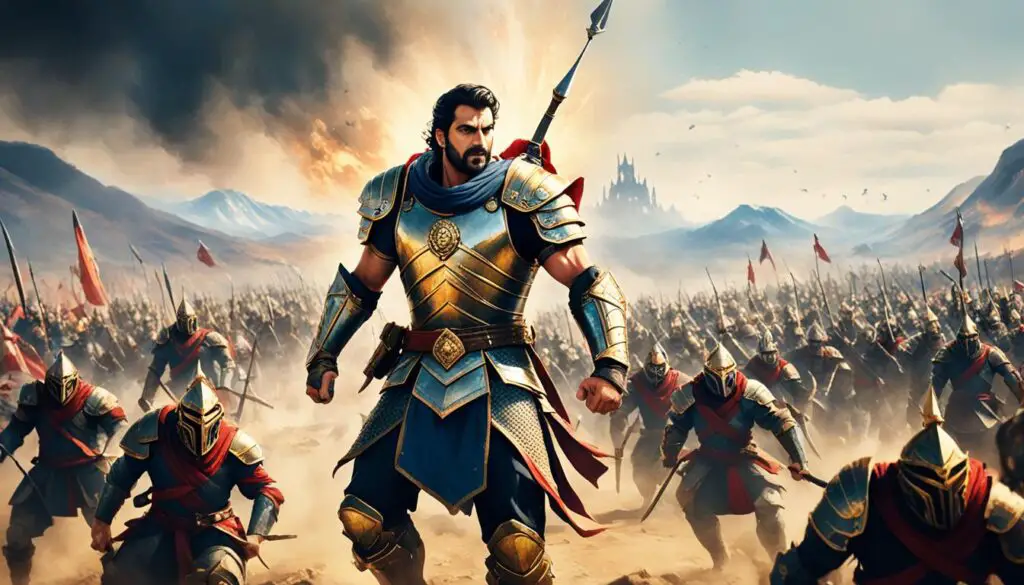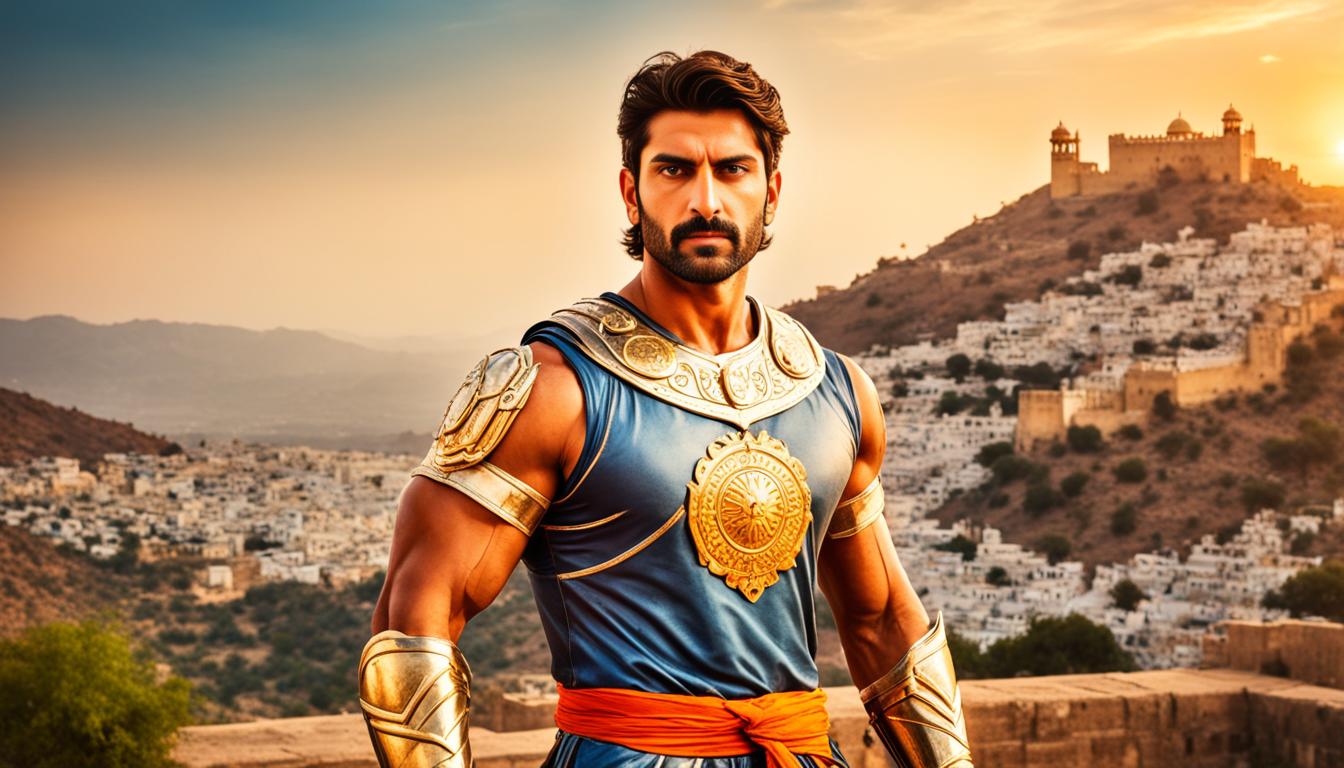Have you ever wondered what it takes to become a legendary ruler? Meet Rana Sanga, the Mewar monarch who epitomized Rajput valor and resistance in medieval India. Born in a time of turmoil and invasions, Rana Sanga rose to power, united the Rajput kingdoms, and became a symbol of courage and determination. But what were the defining moments that shaped this remarkable ruler? Let’s dive into the extraordinary life of Rana Sanga and uncover the secrets behind his indomitable spirit.
Key Takeaways:
- Rana Sanga, the ruler of Mewar, was known for his valor and resistance against Muslim invasions in medieval India.
- Despite losing an eye in a family dispute, Rana Sanga forgave his brothers, demonstrating his kindness and character.
- He united the Rajput kingdoms under the cause of “Swaraj” (self-rule) and became a major Rajput state known for its bravery.
- Rana Sanga’s battles and wars against Muslim rulers, including the Delhi Sultanate and Mughal Empire, showcased his determination to protect Rajput supremacy.
- His legacy of bravery, humility, and dedication to his motherland continues to inspire generations, making him one of the greatest Rajput warriors in history.
The Birth and Rise of Rana Sanga
Rana Sanga, a prominent figure in the history of India, was born in 1482 into the revered Mewar royal family, which belonged to the illustrious Sisodia Dynasty. Growing up in a tumultuous era characterized by frequent Muslim invasions and internal conflicts among Rajput states, Rana Sanga inherited the valor and determination that had defined his ancestors for generations.
Despite facing a harrowing incident during his childhood when his own brothers attempted to take his life, Rana Sanga displayed exceptional forgiveness and resilience. Undeterred by the betrayal, he embarked on a transformative journey that led him to seek refuge as a shepherd in Marwar, a rival Rajput kingdom.
For a span of three years, Rana Sanga embraced anonymity, honing his skills and preparing himself for the challenges that lay ahead. His unwavering determination and unwavering courage became his guiding forces during this period of self-imposed exile.

Following a series of significant events and shifting tides, Rana Sanga was ultimately brought back to Mewar, where he ascended the throne in 1508 following the demise of his elder brothers. With his firm grip on power, Rana Sanga emerged as a formidable leader, ready to protect and uphold the honor of Mewar and its people.
Rana Sanga’s Contribution and Legacy
Rana Sanga, the valiant ruler of Mewar, left an indelible mark on the history of medieval India. His reign was characterized by his unwavering determination to unite the Rajput kingdoms and establish Rajput supremacy. Through his fearless leadership, he led numerous battles and wars against Muslim rulers, including the Delhi Sultanate and the mighty Mughal Empire.
Notable among his military campaigns are the Battle of Gagron, Battle of Khatoli, and the decisive Battle of Khanwa. These conflicts showcased his strategic prowess and unwavering dedication to defending his motherland. Although he faced defeat in the battle against Babur, the founder of the Mughal Empire, Rana Sanga’s resilience remained unbroken. Defying Mughal expansion, he even provided refuge to the Mughal prince, Humayun, in his hour of need.
Rana Sanga’s bravery and humility continue to inspire generations. He is revered as one of the greatest Rajput warriors in history, leaving behind a legacy of courage and steadfastness. His relentless pursuit of Rajput supremacy and his unwavering commitment to the welfare of Mewar make him an iconic figure in Indian history.

Notable Battles and Wars Led by Rana Sanga:
- Battle of Gagron
- Battle of Khatoli
- Battle of Khanwa
“Rana Sanga’s bravery and humility continue to inspire generations. He is revered as one of the greatest Rajput warriors in history, leaving behind a legacy of courage and steadfastness.”
Conclusion
In conclusion, Rana Sanga was a legendary Rajput ruler from Mewar whose valor and resistance during medieval India left an indelible mark on history. Born into a time of turmoil and conflict, he rose to power and united the Rajput kingdoms, embodying the spirit of “Swaraj” or self-rule. Despite losing an eye in a family dispute, Rana Sanga’s forgiveness and kindness exemplified his noble character.
Throughout his reign, Rana Sanga demonstrated unwavering determination in his quest for Rajput supremacy. He led numerous battles against Muslim rulers, including the Delhi Sultanate and Mughal Empire, leaving behind a legacy of bravery and resilience. Although he faced defeat in the Battle of Khanwa against Babur, his resistance to Mughal expansion persisted, even extending compassion to the Mughal prince, Humayun.
Rana Sanga’s contributions to Mewar and the Rajput community have had a lasting impact. His bravery, humility, and dedication to his motherland continue to inspire successive generations. Recognized as one of the greatest Rajput warriors in history, Rana Sanga’s story serves as a reminder of the valor and fighting spirit that defined medieval India.
FAQ
Who was Rana Sanga?
Rana Sanga, also known as Maharana Sangram Singh, was a legendary Rajput ruler from Mewar who epitomized valor and resistance in medieval India.
When was Rana Sanga born?
Rana Sanga was born in 1482 into the royal family of Mewar, belonging to the Sisodia Dynasty.
What was Rana Sanga’s goal?
Rana Sanga’s goal was to unite the Rajput kingdoms and fight for Rajput supremacy.
Who were Rana Sanga’s adversaries?
Rana Sanga fought battles and wars against Muslim rulers, including the Delhi Sultanate and Mughal Empire.
Which battles were notable during Rana Sanga’s reign?
Notable battles during Rana Sanga’s reign include the Battle of Gagron, Battle of Khatoli, and the Battle of Khanwa.
Did Rana Sanga succeed in his battles against Babur?
Rana Sanga suffered a defeat in the battle against Babur but continued to resist Mughal expansion.
What was Rana Sanga’s legacy?
Rana Sanga’s bravery, humility, and dedication to his motherland continue to inspire generations, and he is considered one of the greatest Rajput warriors in history.
Source Links
- https://www.geeksforgeeks.org/rana-sanga-biography/
- https://theenticedsage.medium.com/rana-sanga-the-wounded-lion-of-mewar-ba07370dc43f
- https://edurev.in/question/3280527/Who-amongst-the-following-ascended-the-throne-of-Mewar-in-1509-A-D–was-popularly-known-as-Rana-Sang
